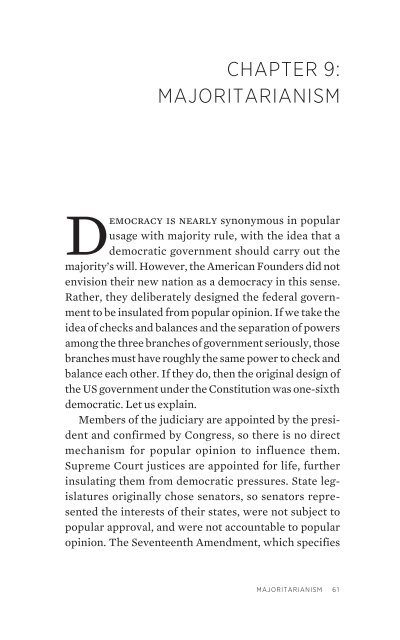url?sa=t&source=web&cd=1&ved=0CCYQFjAA&url=http://mercatus.org/sites/default/files/Holcombe_Cronyism_web
url?sa=t&source=web&cd=1&ved=0CCYQFjAA&url=http://mercatus.org/sites/default/files/Holcombe_Cronyism_web
url?sa=t&source=web&cd=1&ved=0CCYQFjAA&url=http://mercatus.org/sites/default/files/Holcombe_Cronyism_web
Create successful ePaper yourself
Turn your PDF publications into a flip-book with our unique Google optimized e-Paper software.
CHAPTER 9:<br />
MAJORITARIANISM<br />
Democracy is nearly synonymous in popular<br />
usage with majority rule, with the idea that a<br />
democratic government should carry out the<br />
majority’s will. However, the American Founders did not<br />
envision their new nation as a democracy in this sense.<br />
Rather, they deliberately designed the federal government<br />
to be insulated from popular opinion. If we take the<br />
idea of checks and balances and the separation of powers<br />
among the three branches of government seriously, those<br />
branches must have roughly the same power to check and<br />
balance each other. If they do, then the original design of<br />
the US government under the Constitution was one-sixth<br />
democratic. Let us explain.<br />
Members of the judiciary are appointed by the president<br />
and confirmed by Congress, so there is no direct<br />
mechanism for popular opinion to influence them.<br />
Supreme Court justices are appointed for life, further<br />
insulating them from democratic pressures. State legislatures<br />
originally chose senators, so senators represented<br />
the interests of their states, were not subject to<br />
popular approval, and were not accountable to popular<br />
opinion. The Seventeenth Amendment, which specifies<br />
MAJORITARIANISM 61


